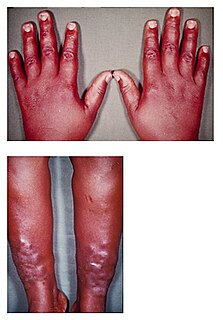
A disease is a particular abnormal condition that negatively affects the structure or function of part or all of an organism, and that is not due to any external injury. Diseases are often construed as medical conditions that are associated with specific symptoms and signs. A disease may be caused by external factors such as pathogens or by internal dysfunctions. For example, internal dysfunctions of the immune system can produce a variety of different diseases, including various forms of immunodeficiency, hypersensitivity, allergies and autoimmune disorders.

An eponym is a person, place, or thing after whom or after which something is named, or believed to be named. The adjectives derived from eponym include eponymous and eponymic. For example, Elizabeth I of England is the eponym of the Elizabethan era, and "the eponymous founder of the Ford Motor Company" refers to Henry Ford. Recent usage, especially in the recorded-music industry, also allows eponymous to mean "named after its central character or creator", but in most cases, the better term would be "title character".

Edema, also spelled oedema or œdema, is an abnormal accumulation of fluid in the interstitium, located beneath the skin and in the cavities of the body, which can cause severe pain. Clinically, hyperaldosteronism, edema manifests as swelling. The amount of interstitial fluid is determined by the balance of fluid homeostasis and the increased secretion of fluid into the interstitium. The word is from Greek οἴδημα oídēma meaning "swelling". The condition is also known as dropsy.
Nosology is the branch of medical science that deals with the classification of diseases.

Elephantiasis is the enlargement and hardening of limbs or body parts due to tissue swelling. It is characterised by oedema, hypertrophy, and fibrosis of skin and subcutaneous tissues, due to obstruction of lymphatic vessels. It may affect the genitalia. The term elephantiasis is often used in reference to parasitic worm infections, but may refer to variety of diseases where parts of a person's body swell to massive proportions.
Phlegm is a liquid secreted by the mucous membranes of mammals. Its definition is limited to the mucus produced by the respiratory system, excluding that from the nasal passages, and particularly that which is expelled by coughing (sputum). Phlegm is in essence a water-based gel consisting of glycoproteins, immunoglobulins, lipids and other substances. Its composition varies depending on climate, genetics, and state of the immune system. Its color can vary from transparent to pale or dark yellow and green, from light to dark brown, and even to dark grey depending on the constituents. The body naturally produces a quart of phlegm every day to capture and clear substances in the air and bacteria from the nose and throat.

Myxedema is a term used synonymously with severe hypothyroidism. However, the term is also used to describe a dermatological change that can occur in hypothyroidism and some forms of hyperthyroidism. In this latter sense, myxedema refers to deposition of mucopolysaccharides in the dermis, which results in swelling of the affected area. One manifestation of myxedema occurring in the lower limb is pretibial myxedema, a hallmark of Graves disease, an autoimmune form of hyperthyroidism. Myxedema can also occur in Hashimoto's thyroiditis and other long-standing forms of hypothyroidism.

Peau d'orange describes anatomy with the appearance and dimpled texture of an orange peel. Peau d'orange is caused by cutaneous lymphatic edema, which causes swelling. However, the infiltrated skin is tethered by the ligament of Cooper such that it cannot swell, leading to an appearance like orange skin. Occasionally, the same phenomenon is seen over a chronic abscess. Examples include the skin of the breast in inflammatory breast cancer, in the eye due to breaks in Bruch's Membrane called angioid streaks, which are common in pseudoxanthoma elasticum, or in elephantiasis caused by thread-like, microscopic parasitic worms (filariasis). Peau d'orange can be also seen with myxedema of Grave's disease, where the term refers more to the texture than the color.
William Bennett Bean was a well-known internist, medical historian and teacher.

Hyman Isaac Goldstein was an American physician and medical historian born in Baltimore, Maryland. He was the eldest son of Rose and Solomon Joseph Goldstein.

Graves ophthalmopathy,also known as thyroid eye disease (TED), is an autoimmune inflammatory disorder of the orbit and periorbital tissues, characterized by upper eyelid retraction, lid lag, swelling, redness (erythema), conjunctivitis, and bulging eyes (exophthalmos). It occurs most commonly in individuals with Graves' disease, and less commonly in individuals with Hashimoto's thyroiditis, or in those who are euthyroid.
In medicine, Infantilism is an obsolete term for various, often unrelated disorders of human development, up to developmental disability, which consist of retention of the physical and/or psychological characteristics of early developmental stages into a relatively advanced age.

William Osler Abbott was a United States physician, son of Dr. Alexander C. Abbott and Georgina Osler. His most notable contribution to the field of medicine was his part in the development of the Miller-Abbott tube, used in decompression and stenting of the small intestine, alongside Thomas Grier Miller, and also for devising the Abbot Rawson tube. Abbot received his MD in 1928 from the University of Pennsylvania. He died of myelogenous leukemia in Waquoit, Massachusetts on September 10, 1943.

Emil Ponfick was a German pathologist born in Frankfurt am Main.

A symptom is a departure from normal function or feeling which is apparent to a patient, reflecting the presence of an unusual state, or of a disease. A symptom can be subjective or objective. Tiredness is a subjective symptom whereas cough or fever are objective symptoms. In contrast to a symptom, a sign is a clue to a disease elicited by an examiner or a doctor. For example, paresthesia is a symptom, whereas erythema is a sign. Symptoms and signs are often nonspecific, but often combinations of them are at least suggestive of certain diagnoses, helping to narrow down what may be wrong. In other cases they are specific even to the point of being pathognomonic.

Professor Pieter Klazes Pel was a Dutch physician and professor of internal medicine.















